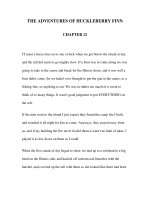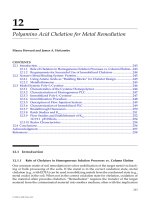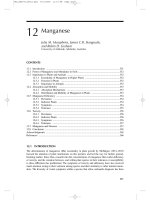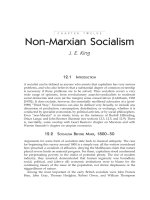Survey of accounting 6e chapter 12
Bạn đang xem bản rút gọn của tài liệu. Xem và tải ngay bản đầy đủ của tài liệu tại đây (2.87 MB, 39 trang )
Differential Analysis and
Product Pricing
Chapter
12
©2013 Cengage Learning. All Rights Reserved. May not be scanned, copied or duplicated, or posted to a publically accessible website, in whole or in part.
Learning Objectives
©2013 Cengage Learning. All Rights Reserved. May not be scanned, copied or duplicated, or posted to a publically accessible website, in whole or in part.
Learning
Objective 1
Prepare differential analysis reports for a
variety of managerial decisions.
©2013 Cengage Learning. All Rights Reserved. May not be scanned, copied or duplicated, or posted to a publically accessible website, in whole or in part.
Differential Analysis
Step 1: Identify the
______ of the decision
Step 2: Identify the ______
courses of action
Step 4: Make a ________
Step 4: _______, ______,
and ______ the results of
the decision
Step 3: Gather relevant
___________
©2013 Cengage Learning. All Rights Reserved. May not be scanned, copied or duplicated, or posted to a publically accessible website, in whole or in part.
Differential Analysis
• Differential analysis looks at the effects of
different alternatives.
– _________________________________
– _________________________________
– _________________________________
©2013 Cengage Learning. All Rights Reserved. May not be scanned, copied or duplicated, or posted to a publically accessible website, in whole or in part.
Differential Analysis in Six
Situations
1.
2.
3.
4.
5.
6.
Leasing or selling equipment
Discontinuing an unprofitable segment
Manufacturing or purchasing a needed part
Replacing fixed assets
Processing further or selling an intermediate product
Accepting additional business at a special price
©2013 Cengage Learning. All Rights Reserved. May not be scanned, copied or duplicated, or posted to a publically accessible website, in whole or in part.
Lease or Sell
• Karnes Company has
equipment to dispose. The
equipment originally cost
$200,000, and accumulated
depreciation is $120,000.
• Two alternatives:
• Lease the equipment for
$160,000 less $35,000 in
repairs, taxes, etc.
• Sell the equipment for $100,000
less 6% commission.
©2013 Cengage Learning. All Rights Reserved. May not be scanned, copied or duplicated, or posted to a publically accessible website, in whole or in part.
Lease or Sell
Exhibit 2: Differential Analysis Report-Lease or Sell
Exhibit 3: Traditional Analysis
Decision:
Leasing the
equipment
would increase
overall income
by $31,000.
NOTE: The $80,000 book value is a sunk cost and is ignored in differential analysis.
©2013 Cengage Learning. All Rights Reserved. May not be scanned, copied or duplicated, or posted to a publically accessible website, in whole or in part.
Discontinue a Segment or Product
• Montana Wheat Cereal Co. produces and sells three
kinds of cereal. Bran Flakes exhibits an operating loss so
the company is considering discontinuing production and
sale of the product.
• If fixed costs remain the same, is this the right decision?
Exhibit 4: Income (Loss) by Product
©2013 Cengage Learning. All Rights Reserved. May not be scanned, copied or duplicated, or posted to a publically accessible website, in whole or in part.
Discontinue a Segment or Product
Exhibit 5: Differential Analysis Report- Discontinue an Unprofitable Segment
Exhibit 6: Traditional Analysis
Decision:
Discontinuing
Bran Flakes
would reduce
overall profit by
$15,000
because that is
the amount that
Bran Flakes
contributes to
covering
_______.
©2013 Cengage Learning. All Rights Reserved. May not be scanned, copied or duplicated, or posted to a publically accessible website, in whole or in part.
Make or Buy
• An automobile company has
been buying a part for $240 per
unit. It is considering making
the part at the following cost:
–
–
–
–
–
$80 in direct materials
$80 in direct labor
$52 in variable overhead
$68 in fixed overhead
80% capacity
• Should the company make or
buy the part?
©2013 Cengage Learning. All Rights Reserved. May not be scanned, copied or duplicated, or posted to a publically accessible website, in whole or in part.
Make or Buy
Exhibit 7: Differential Analysis Report- Make or Buy
Decision:
Making the
instrumental
panels will
provide a
cost saving
of $28 per
unit
because
fixed costs
will not
change.
Focus the analysis on differential costs.
Since the automobile company has excess factory capacity,
______ costs will not change and hence they are irrelevant to the
decision.
©2013 Cengage Learning. All Rights Reserved. May not be scanned, copied or duplicated, or posted to a publically accessible website, in whole or in part.
Replace Equipment
• A manufacturer is considering
replacing several old machines
with a new one.
– Total book value of the old machines:
$100,000.
– Total remaining useful life of the old
machines is 5 years.
– New machine cost $250,000; 5-year
useful life.
– The old equipment can be sold for
$25,000.
– The new machine will reduce annual
variable costs from $225,000 to
$150,000.
• Should the company buy the new
machine?
©2013 Cengage Learning. All Rights Reserved. May not be scanned, copied or duplicated, or posted to a publically accessible website, in whole or in part.
Replace Equipment
Exhibit 8: Differential Analysis Report - Replace Machine
Decision:
Replacing the
old equipment
with the new
equipment will
provide an
annual
decrease in
cost of $30,000.
Focus the analysis on relevant costs.
The book value of the equipment ($100,000) is a _______ and is not
considered. Relevant costs include the cost savings of more
efficient equipment, product quality, etc.
©2013 Cengage Learning. All Rights Reserved. May not be scanned, copied or duplicated, or posted to a publically accessible website, in whole or in part.
Opportunity Cost
• Measures the amount of revenue that is foregone from
an alternative use of an asset.
• Assume that the $250,000 for the new equipment less
the $25,000 sale proceeds could be invested to yield a
15% return.
• The annual opportunity cost of the new equipment is
$33,750 ($225,000 × 15%).
• It is not beneficial to replace the equipment for an annual
cost savings of $30,000.
©2013 Cengage Learning. All Rights Reserved. May not be scanned, copied or duplicated, or posted to a publically accessible website, in whole or in part.
Process or Sell
• A 4,000 gallon batch of
kerosene sells at $0.80 per
gallon; produced from 4,000
gallons of raw material costing
$0.60 per gallon.
• Alternatively, could continue
processing these raw material
into gasoline selling at $1.25
per gallon for an additional
cost of $650 per batch; 20% of
the gallons of kerosene will
evaporate during production.
• Should the company sell or
process further?
©2013 Cengage Learning. All Rights Reserved. May not be scanned, copied or duplicated, or posted to a publically accessible website, in whole or in part.
Process or Sell
Exhibit 9: Differential Analysis Report – Process or Sell
Initial raw material cost will be incurred in both alternatives and is
not considered.
The differential revenue and the cost to process the batch further
will be the focus.
©2013 Cengage Learning. All Rights Reserved. May not be scanned, copied or duplicated, or posted to a publically accessible website, in whole or in part.
Accept Business at a Special
Price
• A company currently produces an
average of 10,000 basketballs per
month; factory has a monthly
capacity of 12,500 basketballs.
– Variable costs are $12.50 per ball.
– Fixed costs are $7.50 per ball.
– The domestic selling price is $30 per
ball.
• The company received an offer for
5,000 additional basketballs at $18
each from a foreign buyer. The balls
can be produced over 3 months.
• Should the company accept the
offer?
©2013 Cengage Learning. All Rights Reserved. May not be scanned, copied or duplicated, or posted to a publically accessible website, in whole or in part.
Accept Business at a Special
Price
Exhibit 9: Differential Analysis Report – Sell at Special Price
The company has excess capacity and can produce additional
product without incurring additional fixed costs.
Whether differential revenue covers relevant costs and produces
income is the issue.
©2013 Cengage Learning. All Rights Reserved. May not be scanned, copied or duplicated, or posted to a publically accessible website, in whole or in part.
Learning
Objective 2
Determine the selling price of a
product, using the total cost, product
cost, and variable cost concepts
©2013 Cengage Learning. All Rights Reserved. May not be scanned, copied or duplicated, or posted to a publically accessible website, in whole or in part.
Setting Normal Product Selling
Prices
• In the long run, the normal selling price must be
enough to cover all expenses and provide a
reasonable profit.
• Approaches for setting prices:
• ___________
• ___________
©2013 Cengage Learning. All Rights Reserved. May not be scanned, copied or duplicated, or posted to a publically accessible website, in whole or in part.
Market Methods
• _____________ concept – set the selling price
according to demand for the product.
• _____________ concept – set the price according to
the price offered by competitors.
©2013 Cengage Learning. All Rights Reserved. May not be scanned, copied or duplicated, or posted to a publically accessible website, in whole or in part.
Cost-Plus Methods
Managers price the product in order to achieve a
target profit. The price covers all costs plus a
profit.
• _____ Cost Concept
• Markup added to all costs (including selling &
administrative).
• _____ Cost Concept
• Markup added to product costs.
• ______ Cost Concept
• Markup added to variable costs.
©2013 Cengage Learning. All Rights Reserved. May not be scanned, copied or duplicated, or posted to a publically accessible website, in whole or in part.
Cost-Plus Examples
UNIT VARIABLE COSTS
We’ll use these facts
to illustrate the three
cost-plus methods.
Direct materials
Direct labor
$ 3.00
10.00
Factory overhead
1.50
Selling & admin. exp.
1.50
Total
$ 16.00
FIXED COSTS
Factory overhead
Selling & admin. exp.
$50,000
20,000
©2013 Cengage Learning. All Rights Reserved. May not be scanned, copied or duplicated, or posted to a publically accessible website, in whole or in part.
Total Cost Concept
Markup % =
• Nebular Inc. desires a profit equal to 20% of total assets. If
total assets are $800,000, the desired profit is $160,000, or
$1.60 per unit, assuming 100,000 units.
• Assuming 100,000 units, the total cost per unit is as follows:
•
After adding the markup to the total cost the selling price per unit is:
©2013 Cengage Learning. All Rights Reserved. May not be scanned, copied or duplicated, or posted to a publically accessible website, in whole or in part.









